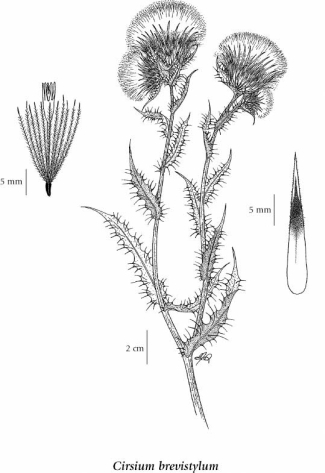short-styled thistle (clustered thistle)
Asteraceae (Aster family)
Introduction to Vascular Plants
Species Information
General:
Short-lived perennial herb from a taproot; stems erect, crisp-cobwebby, unwinged, simple or sparsely branched above, 0.6-1.2 (3.0) m tall.
Leaves:
Basal and lower stem leaves oblanceolate, up to 30 cm long; middle and upper stem leaves elliptic to oblong, 10-15 cm long, usually lobed 1/3 or 1/2 the width of the blade, sometimes nearly entire, margins bearing slender yellow spines up to 4 mm long, crisp-cobwebby above, often thinly woolly below.
Flowers:
Heads discoid, 3-6, in a terminal cluster; involucres 2-4 cm tall; involucral bracts densely cobwebby, linear-lanceolate, not much graduated, outer ones tapering to a slender, 2-3 mm spine, inner ones unarmed, sometimes irregularly-margined and twisted; disk flowers purplish-red, rarely white, 20-25 mm long, the tubes 12-18 mm long, the lobes 2-4 mm long; styles exserted out of the tubes about 1.5 mm or included.
Fruits:
Achenes 4-4.5 mm long; pappus 18-22 mm long, buff or light brown, subequal to the corolla.
Notes:
A natural hybrid between Cirsium brevistylum and C. edule collected at several sites on S Vancouver Island has been named C. x vancouverense Moore & Frankton. These plants, although most similar to C. brevistylum, have the longer (4 mm) exserted styles and leaf lobes of C. edule.
Illustration

If more than one illustration is available for a species (e.g., separate illustrations were provided for two subspecies) then links to the separate images will be provided below. Note that individual subspecies or varietal illustrations are not always available.
Illustration Source: The Illustrated Flora of British Columbia
Ecology
The table below shows the species-specific information calculated from
original data (BEC database) provided by the BC Ministry of Forests and Range.
(Updated August, 2013)
| Site Information |
Value / Class |
||
|
Avg |
Min |
Max |
|
| Elevation
(metres) |
842 | 473 | 1639 |
| Slope
Gradient (%) |
26 | 0 | 70 |
|
Aspect (degrees) |
190 | 130 | 270 |
| Soil
Moisture Regime (SMR) [0 - very xeric; 4 - mesic; 8 - hydric] |
2 | 0 | 4 |
| Modal
Nutrient Regime
Class |
C | ||
| #
of field plots species was recorded in: |
9 | ||
| Modal
BEC Zone Class |
CWH | ||
|
All BEC Zones (# of stations/zone) species was recorded in |
CWH(3), ESSF(1), IDF(2), PP(2) | ||
|
Source:
Klinkenberg 2013
|
|||
Habitat and Range
Moist meadows and open forests in the lowland and montane zones; frequent in coastal and extreme S BC; S to ID, MT and CA.Status Information
Taxonomic Keys
TAXONOMIC KEY TO CIRSIUM
1. Heads small; involucres 1-2 (rarely 2.5) cm tall; plants introduced.
2. Stems distinctly spiny-winged; plants with perfect flowers C. palustre 1. Heads large; involucres more than 2 cm tall; plants native (except C. vulgare).
3. Leaves bristly-spiny above, stems distinctly spiny-winged............ C. vulgare
4. Pappus of mature seeds exceeding the corollas by 1-10 mm.............. C. foliosum
5. Heads large; involucres 3-5 cm tall........... C. drummondii 6. Outer involucral bracts more than 2 mm wide at base, slightly if at all hairy and if so, then mainly marginal.
7. Outer involucral bracts strongly glandular; lowermost leaves deeply pinnately lobed more than 1/2 the width of the blade.............. C. undulatum 6. Outer involucral bracts less than 2 mm wide at base, densely cobwebby.
8. Corollas white or creamy-white, rarely pinkish; involucral bracts greenish............. C. hookerianum
9. Styles exceeding the corollas by at least 3 mm; achenes 5-6.5 mm long; leaves usually lobed more than 1/2 the width of the blade.............. C. edule Source: Illustrated Flora of British Columbia |